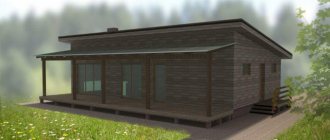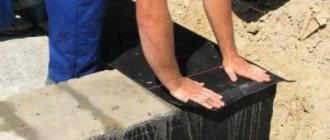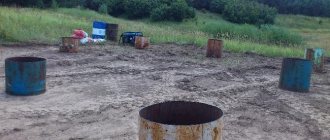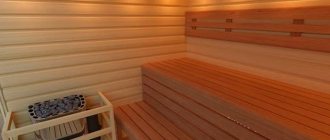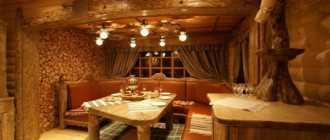The design of such a roof requires a minimum of construction costs and is used over residential buildings, outbuildings, entrance lobbies and verandas. Making a pitched roof with your own hands is very simple; you need to correctly calculate the amount of material taking into account the snow load on the roof and select the finishing roofing material. The design does not require a large drainage system; the gutter is mounted on the underside of the slope and precipitation is discharged spontaneously.
Advantages and disadvantages
Shed roofs are considered the most inexpensive and easiest to install. And this is true, especially with the small width of the building. However, in our country, houses with pitched roofs are very rare. For the most part, this is due to the fact that two or four pitched roofs are more familiar to us - they look more familiar. The second snag is to find a project adapted to our weather conditions. There are a lot of projects on Western resources, but they are designed for a milder climate and, as a rule, have a large glazing area. Finding an architect who will competently change a project you like is very difficult. But if you succeed, and the harmony of the building is not disturbed, the house turns out to be very original.
One of the projects of houses with a pitched roof
Many people are afraid of uneven ceilings in some parts of the building. They are, of course, more difficult to beat than standard ones, but the result is of a completely different level - 100% original. True, this time it is very difficult to find a designer who can develop such an interior in the vastness of our Motherland, but nevertheless, it is possible.
There is another way out - to level the ceilings by overlapping, and use the free space under the roof as technical rooms. Such options have been implemented and the owners are very satisfied. Yes, the technical rooms are on the ground floor and upstairs, but there are no problems with groundwater.
These are, perhaps, all the disadvantages or pitfalls that a pitched roof can bring. There is, however, one more point that can hardly be called a disadvantage. Due to the peculiarity of the structure, the roofing material on such houses is not visible from the ground. If the terrain is flat, without large differences in elevation, there is no point in bothering with the appearance of the roof. It is better to choose simple-looking, but high-quality materials, quiet (the flat surface is large, it makes a lot of noise when it rains) and reliable. One of the popular options is seam roofing. It provides the proper degree of tightness and is not very noisy. Another option is a soft fused roof made from modern materials. Such roofs are even quieter, and modern materials can be used for 20-30 years without repair.
Complex architectural solutions
The most complex structures include: domed, conical, vaulted and combined roofs. They are used in the construction of residential buildings, temples and restoration of cultural heritage sites. They decorate small objects - towers, bay windows, gazebos. For complex architectural solutions, it is difficult to choose roofing material (not all are suitable).
Dome and conical shape
The most complex and expensive technology (special support elements are required to support the dome). But this design allows you to get a surprisingly beautiful appearance. Installation of windows in this design is excluded.
Vaulted roofs
Such roofs are similar to arches - a semicircle above the house (they use a curved profile). Typically, vaulted structures are used as a canopy over a structure (for example, a gazebo).
Combined roofs
They are used in the construction of large private houses of complex shape. To create a combined roof, various modern technologies (described above) are used. When planning, you need to carefully consider the future design so that each element is in harmony with the others and you get a cohesive image. Such houses, with the right approach, become like castles. Contact: our specialists have extensive experience in roofing work and appropriate qualifications. We will carry out any project with high quality: we undertake the construction of pitched roofs of any type! We work in Lipetsk and throughout the region. Travel to neighboring regions is possible. Photo gallery of pitched roofs
Construction of a pitched roof
Organize the required slope of the pitched roof due to the difference in heights of the opposite walls. One wall of the building turns out to be significantly higher than the other. This leads to increased consumption of materials for the walls, but the rafter system is very simple, especially for buildings of small width.
Shed roof
If the load-bearing capacity of the walls is sufficient, the truss system of a pitched roof rests on a mauerlat attached to the wall. To make the load distribution more uniform, the top row of the wall masonry is reinforced with longitudinal reinforcement (for brick walls, concrete blocks) or an armored belt is poured over the last row (for walls made of lightweight concrete, limestone, shell rock). In the case of a wooden or frame structure, the role of the Mauerlat is usually performed by the last crown or top trim.
If the building material of the walls is insufficiently strong, most of the load can be transferred to the ceiling. To do this, install racks (steps of about 1 meter), on which purlins are laid - long bars running along the building. The rafter legs then rest on them.
How to transfer the load from the walls to the floor
When pouring an armored belt or laying the last row, studs are installed into it in increments of 80-100 cm, with the help of which the mauerlat is then attached to the walls of the building. In wooden houses, if you do not make an armored belt, it is impossible to install studs. In this case, installation on pins with a hexagonal head is allowed. Under the pin, through the Mauerlat, a hole is drilled, a couple of millimeters smaller than the diameter of the pin. A metal rod is driven into it, which attracts the wooden beam to the wall. The connection is tightened using a hex wrench of the required size.
Types of roof supports
The design of a pitched roof is based on rafter legs that rest on the front wall on one side and on the back wall on the other. The front wall must be higher than the back wall to ensure the required angle of inclination of the roofing system.
If the distance between the walls does not exceed 4.5 m, the roof structure will be simple: two mauerlat beams fixed on the walls and rafter legs resting on the mauerlat.
When the gap between the ceiling and the roof does not exceed 4.5 m, the structure can be mounted without installing additional supports. If the gap is more than 4.5 m, you will need to install support posts under the rafters. Boards or beams can be used as supports.
There are two ways to install supports:
- Installing supports in the center of the rafter length.
- Installation of a horizontal purlin from one beam under the rafters, running in the middle of their length. This option will reduce the number of support posts by half.
If the building width is more than 6 m, the design of the rafter system will be more complex. The optimal solution in this case is to design a house with a load-bearing wall, which will act as a support for the racks.
The diagram shows the principles for installing rafter legs, racks and purlins depending on the width of the building. If the width of the room reaches 16 m, a screed must be installed between the two support postsIf the house is more than 12 m wide, additional rafter legs must be used. Manufacturing beams of non-standard size will entail increased financial costs. In some cases, this can be avoided with the help of fillies.
By installing fillets, the length of the beams is spliced. This option is available if only the missing width of the roof overhangs is increased
The fillies are sections of beams of a similar cross-section, connected to the main beams and fixed with two 60 cm pads. This structure is fastened with bolts or mounting plates.
Rafter system of a pitched roof
Such roofs are especially popular in the construction of courtyard buildings - sheds, garages. It’s just that the size of the buildings allows the use of not very powerful beams, and beams are required in small quantities. With a building width of up to 6 meters, the rafter system of a pitched roof contains almost no additional reinforcing elements (supports and purlins), which is beneficial. Also attractive is the absence of complex knots.
For Central Russia, for a span of up to 5.5 meters, beams of 50-150 mm are taken; up to 4 meters, 50-100 mm is enough, although in an amicable way, you need to consider the snow and wind load specifically in your region, and, based on this, decide with beam parameters.
Rafter system of a pitched roof with a small span (up to 6 meters)
With a distance between the walls of up to 4.5 meters, the pitched roof consists of two mauerlat bars fixed to the walls, and rafter legs that rest on the mauerlat. Really very simple design.
With a span width of 4.5 meters to 6 meters, a support is also required, fixed to a higher wall at the floor level and a rafter leg that rests on the beam almost in the middle. The slope angle of this beam depends on the distance between the walls and the level of installation of the beam.
More complex rafter systems in a pitched roof with a building width of more than 6 meters. In this case, it is optimal if the house is designed in such a way that there is also a load-bearing wall inside on which the racks rest. With a house width of up to 12 meters, the trusses are still simple, and the cost of installing the roof is minimal.
Construction of pitched roof trusses for buildings with a width of more than 6 meters
For buildings more than 12 meters wide, the system becomes more complex - there are more rafter legs. In addition, manufacturing beams longer than 6 meters is expensive. If an increase is required only by the width of the roof overhangs, the beams are extended along the edges with fillets. These are pieces of beams of the same cross-section, connected to the beam and secured on the sides with two wooden plates at least 60 cm long, fastened with bolts or nails, allowing the use of mounting plates.
Option for splicing rafters
If the total length of the beam is more than 8 meters, they are usually spliced. The joints are further reinforced by nailing boards or mounting plates.
Options for attaching the rafters to the mauerlat: sliding at the top and rigid at the top on the right. Below on the right is a version of a tie-in without overhangs (very rarely used)
There may also be questions about how to attach the rafters of pitched roofs to the Mauerlat. There are no fundamental differences. Everyone also makes a cutout in the rafter leg, with which the beam rests on the mauerlat. In order not to suffer with each rafter leg, leveling its fit, having cut out the first one, a template is made from a piece of board, thick plywood or timber that exactly repeats the resulting “cut”. All subsequent rafters are sawn before installation. A template is applied to them in the right place, a recess of the required shape and size is outlined and cut out.
This was about rigidly attaching the rafter legs to the mauerlat. It is used on all buildings that exhibit low shrinkage. This method of fastening cannot be used on wooden houses - the house always settles or rises slightly, which can cause misalignment. If the roof is fixed tightly, it may tear. Therefore, when installing a pitched or any other roof on wooden houses, a sliding connection of rafters and mauerlat is used. For this there are so-called “slippers”. These are plates, consisting of corners that are attached to the mauerlat and metal strips movably connected to them, which are attached to the rafter leg. Two such slips are placed on each rafter.
Materials required for installation
To install a pitched roof, you will need a minimum set of tools - a hammer, a hacksaw or saw, an ax, a knife, a construction stapler, a measuring level and a screwdriver. It is better to use the equipment on batteries so as not to pull electrical wires throughout the entire structure. Necessary materials:
- dry timber with a moisture content of less than 20% and a minimum size of 100x100 mm for the Mauerlat and 50x70 mm for the racks;
- 1st grade edged board made of coniferous and deciduous wood;
- fastening elements: nails, screws, staples, anchor bolts;
- vapor barrier, waterproofing and insulation material;
- finishing roof covering with fasteners.
You will also need additional elements for filing the cornice and a drainage system.
Choosing a roof angle
The roof slope angle is determined by a combination of indicators - wind and snow loads and the type of roofing material. First, the angle is determined according to climatic conditions (depending on the amount of precipitation and wind loads). Then they look at the minimum recommended slope for the selected type of roofing material (in the table below).
| Name of roofing material | Minimum tilt angle (in degrees) |
| Asbestos-cement slate and ondulin | 6° |
| Cement-sand and ceramic tiles | 10° |
| Flexible bitumen shingles | 12° |
| Metal tiles | 6° |
| Asbestos-cement or slate slabs | 27° |
| Galvanized steel, copper, zinc-titanium sheets | 17° |
| Corrugated sheet | 6° |
If the desired angle is greater, everything is fine; if it is less (which happens very rarely), increase it to the recommended one. It is not advisable to make a roof with an angle less than the minimum angle recommended by the roofing manufacturer - it will leak at the joints. To make it easier to navigate, let’s say that for central Russia the recommended slope of a pitched roof is 20°. But it is advisable to calculate the figure for each region, and even for different locations of buildings on the site.
By the way, keep in mind that different manufacturers of the same type of roofing material may require different minimum slopes. For example, laying metal tiles of one brand can be done on roofs with a minimum slope of 14°, another - 16°. And this despite the fact that GOST defines a minimum slope of 6°.
It is also worth remembering that with a slope of up to 12°, in order to ensure the tightness of any roofing material, it is necessary to coat all joints of the material with a liquid waterproofing compound (usually bitumen mastic, less often - roofing sealant).
Mounting the Mauerlat
Mauerlat refers to a roofing element that is installed on a load-bearing wall or installed between floor beams. The Mauerlat supports the rafter legs and transfers the load from the roof structure to the walls of the building.
For a pitched roof, the mauerlat is made of beams that are secured with anchor bolts. When pouring the wall, it is necessary to screw in the anchors in advance for mounting the Mauerlat. Before laying the beams, it is necessary to lay a layer of waterproofing.
It should be noted that the Mauerlat can be made of different materials, depending on what the walls are made of. Thus, anchor bolts are suitable for a wooden structure, reinforcement is suitable for foam blocks, and annealed wire is suitable for a brick wall.
Mauerlat
Determine the height to which you want to raise the wall
To ensure the found slope angle of the pitched roof, it is necessary to raise one of the walls higher. How much higher we will find out by remembering the formulas for calculating a right triangle. Using them we also find the length of the rafter legs.
How to calculate the parameters of a pitched roof
When calculating, do not forget that the length is obtained without taking into account overhangs, and they are needed to protect the walls of the house from precipitation. The minimum overhang is 20 cm. But with such a small protrusion beyond the building, the pitched roof looks short. Therefore, overhangs of at least 60 cm are usually made on one-story buildings. On two-story ones they can be up to 120 cm. In this case, the width of the overhang is determined based on aesthetic considerations - the roof should look harmonious.
Example of a drawing in ScratchUp
The easiest way to determine how much the roof needs to be extended is in design programs that allow you to draw the building to scale and “play” with the overhangs. Everything should be displayed in 3 dimensions (the most popular program is ScratchUp). Twist through different sizes of overhangs, decide which one looks better (if there is no project), and then order/make rafters.
Types of additional elements
Additional elements play a significant role in roofing equipment, so they should not be neglected. Elements for gutters, strips, weather vanes, elements for retaining snow must be installed in order to maintain the functionality of the roof.
Thus, the installation of a pitched roof can be done with your own hands quite efficiently.
You should not omit such indicators as the direction of the wind in the region, the amount of precipitation when calculating the design of the structure, since the frame bears the main load of the roof. In addition, you should not skimp on components.
Additional elements
Photo report from the construction site: a pitched roof on a house made of aerated concrete
A house was built in St. Petersburg. There was no project, there was a general idea, which is presented in the photo. The house is made of aerated concrete, the finishing is plaster, the roof is seam, chosen on the basis of low cost, reliability, and ease of installation.
Idea of a house with a pitched roof
After the walls were removed, an armored belt was poured into them, into which studs (Ø 10 mm) were installed every meter. When the concrete in the armored belt reached the required deterioration, a layer of waterproofing (“Gidroizol”, cut lengthwise into strips of the required width) was laid on the bitumen mastic. A mauerlat - 150-150 mm timber - is laid on top of the waterproofing. All lumber used for roofing is dry and treated with protective impregnations and fire retardants.
Beginning of installation of a pitched roof - laying the Mauerlat
First, they put it in place (lying on the pins, held by assistants), and walk along it, hitting with a hammer on the places where the pins are. The places where the studs stick out are imprinted in the timber. Now they drill holes and simply push it onto the studs.
Since the span turns out to be large, supports made of timber (150-150 mm) were placed on which the purlin was laid, which will support the rafter legs.
Installation of racks and purlins
The width of the roof is 12 meters. This takes into account a 1.2 meter offset from the front side. Therefore, the Mauerlat bars and the purlin “stick out” beyond the walls exactly at this distance.
To ensure the removal of the roof, the mauerlat and purlin stick out from the walls
At first there were doubts about such a large offset - the rightmost beam hangs 2.2 meters. If this offset is reduced, it will be bad for the walls, and the appearance will deteriorate. Therefore, it was decided to leave everything as it is.
Laying rafters
Rafters are laid from two spliced boards 200*50 mm, with a pitch of 580 mm. The boards are nailed together in a checkerboard pattern (top-bottom), with a pitch of 200-250 mm. Nail heads are sometimes on the right, sometimes on the left, in pairs: Two on top/bottom on the right, two on top/bottom on the left, etc.). We space the joints of the boards by less than 60 cm. The resulting beam is much more reliable than a similar solid beam.
The rafters are laid
Method of fastening the rafters
Next, the pie of a pitched roof for this case is as follows (from the attic to the street): vapor barrier, 200 mm stone wool, ventilation gap (lathing, counter-lathing), moisture insulation, roofing material. In this case it is dark gray pural.
An example of a roofing pie for a pitched roof (it’s actually standard)
We will carry out insulation from the inside later, but for now we are laying a Tyvek Solid hydro-windproof membrane (vapor-permeable) on top of the rafters.
We lay a waterproofing windproof vapor-permeable membrane
The membrane is laid from bottom to top and secured with staples. The fabric that is rolled out higher overlaps the one already laid by 15-20 cm. The joint is sealed with double-sided tape (bought together with the membrane). Then the planks are placed on top of the membrane, and on them is a sheathing for a standing seam roof.
Lathing made of boards 25*150 mm
First, the sheathing was made from 25*150 mm boards in increments of 150 mm. After installation, walking around the roof, it was decided to strengthen the sheathing. To do this, we fill 100 mm wide boards between the already laid boards. Now there is a gap of 25 mm between the boards.
Sheathing a pitched roof as a result
Next, hooks were placed on the lower gable for installing the drainage system. They are filled unevenly, since due to the large length of the pediment, it was decided to make two receiving funnels at a distance of 2.8 meters from the edge. To ensure drainage in two directions, such a relief was made.
Filled hooks for the drainage system
Next, you need to bring in pieces of metal (pictures) 12 meters long. They are not heavy, but they cannot be bent, so the “sled” disappears. For lifting, a temporary “bridge” was built connecting the ground and the roof. The sheets were lifted along it.
Lifting sheets along the bridge
Next comes roofing work, which differs depending on the type of roofing material. In this case, it was necessary to solve the problem of thermal expansion of the material - galvanized steel (pural) significantly changes its dimensions when heated/cooled. To ensure freedom of expansion, it was decided to fasten the material to the sheathing by the seam using movable clamps with a freedom of movement of 15-20 mm.
Installation of clamps for seam roofing
Laying seam roofing from pural
After laying the roofing material, what remains is the lining of the overhangs, and they are no different.
The roof needs to be brought to perfection - the overhangs need to be hemmed, but basically it is already ready
Well, the photo below shows what happened after finishing. Very modern, stylish and unusual.
House with a pitched roof - finishing is almost finished
Preparatory stage
The first thing you need to do before you start installing a pitched roof with your own hands is to draw up a drawing and calculate the slope. The amount of material that needs to be purchased will depend on these data - the smaller the angle, the lower the costs.
However, a roof that is too shallow will retain water, increasing the risk of leakage at the joints of the roofing material, and the rafters will be subject to increased stress.
Experts advise relying on the following standards:
- The installation of a single-pitched roof made of corrugated sheets assumes that the angle of inclination of the slope will be at least 20º in order to avoid its sagging under snow pressure. In this case, waterproofing will be needed, especially for slopes longer than 5 meters.
- When using slate or metal tiles for roofing, the slope should be increased to 25-40º. As a last resort, it is worth taking care of high-quality waterproofing.
Projects and photos of houses with a pitched roof
As has already been said, it is difficult to find interesting designs of residential buildings with a pitched roof. So far, these buildings are unpopular with us. Perhaps just because of its originality. This section contains several projects or photos of already built houses. Maybe it will be useful to someone, at least as an idea.
Project of a small house with a pitched roof This house exists. Shed roofs are especially good in areas with a difference in height. A one-story house with a large-area shed roof. A two-story house with terraces on two floors.
Natural tiles require a large roof angle
Large windows are beautiful, but irrational in our climate. A multi-level house is an interesting completed project.
This is a prototype of what is located above
Original house. Under one pitched roof there is a house and outbuildings, and part of it is a canopy over the yard between two buildings
Same project as above, on the other side
Two pitched roofs at different levels
Design
A pitched roof has two support points; the difference in heights determines the slope of the slopes. So, the design consists of the following elements:
- The rafter system is a set of supporting elements that are used to fix the roof slopes.
- Pediments are areas that are limited by slopes and cornice.
- The overhang is the protruding part of the rafter leg, which protects the structure from getting wet in rainy weather.
- Roofing material with a finishing coating that protects against precipitation.
- Insulation – used for thermal insulation of the roof.
Mauerlat is a strong beam that serves as the base of the roof. With its help, the load is distributed evenly.
Rafter legs are strong and even bars from which slopes are formed.
Sheathing is a solid or lattice base on which roofing material is laid.
To perform the installation correctly, you should be aware of all the design features.
How to choose an option: tips
The choice of the shape of a pitched roof depends on several factors: climate and weather conditions, the area of the building, its width, and the purpose of the attic space. Of course, one of the main selection criteria is financial capabilities. Complex projects of hip, gable and hip roofs require a large amount of expensive building materials and professional, responsible work of experienced roofers.
The size and shape of a private house play an important role. If the width of the building is 9 - 18 m, then it is optimal to choose classic triangular ones; for 12 - 24 m, trapezoidal ones are usually used; for 24 - 36 m, complex polygonal ones. If the building is square, then it is optimal to choose a hipped or tambourine roof.
It is better to choose a coating that is modern, durable and pleasant to look at. You should not use old, irrelevant materials for roofing: slate, roofing felt. It is better to spend a certain amount on a beautiful and reliable roof. The leaders among modern roof cladding materials are metal tiles and non-ferrous metal profile sheets.
Carrying out construction activities
The material for the frame must be well dried. Wood moisture content is limited to 20%. Work order:
- The first step is laying the Mauerlat. If the walls are stone, the base for the element is a reinforced concrete belt with waterproofing.
- Installation of the beam is necessary in a layered rafter system. For this purpose, timber with a cross section of 100×200 is used.
- The racks are vertically attached to the bed. If there are no internal walls, the pillars are installed on the floor beams. To temporarily fix the elements, it is recommended to make supports that, using self-tapping screws, hold the racks in an even vertical position. The pitch of the pillars is at least 2 meters. The hip roof provides for the installation of supports on the diagonals.
- The hip system purlin is attached to the tops of the posts.
- The first to be erected are the diagonal rafters, which add rigidity to the central supports and connect the ridge beam to the mauerlat. Angles and brackets are used to secure intermediate rafters.
- The last to be erected in the frame are the trusses. These elements take on the load of the lower quarter of the corner rafters.
- The last stage is laying the sheathing under the roof. It is attached perpendicularly to the rafters. The optimal step is 50 cm.
A professional approach to assembling a durable frame determines the performance qualities of a hipped roof. The resistance to weather conditions and the service life of the structure as a whole depend on the reliability of the structure.
Instructions for performing work
Before making a pitched roof, you need to choose the right lumber for the rafter system and sheathing. In this regard, we will give the following recommendations:
- for a span of up to 4.5 m wide, rafters made of 15 x 5 cm timber are suitable, up to 6 m - from 200 x 50 mm boards, spliced in pairs or lengthwise;
- timber 150 x 50 mm will be used for the wall frame (mauerlat) and the beds;
- cross-section of racks, struts and purlins – 10 x 5 cm;
- the sheathing is made of boards 20-25 mm thick and 10-15 cm wide.
For waterproofing, you will need roofing felt and a superdiffusion membrane, and for laying the finishing coating, metal tiles, corrugated sheets or other roofing material. If we are talking about a residential building, do not forget about insulation: prepare mineral wool of the required thickness (or other insulation) and a vapor barrier film.
Laying the Mauerlat
The strapping beam should be placed on 2 opposite walls, where the rafter legs rest. If it is planned to support the layered system on internal partitions, then a board called a bench is also laid on them. The exception is log and frame houses, whose walls are ready for the installation of rafters.
The technology for laying Mauerlat on walls made of different materials looks like this:
- Studs are pre-embedded into the brickwork, onto which the strapping beam is attached. Before installation, the stone wall is covered with 2 layers of roofing felt. If the studs were not installed, then the Mauerlat is secured with anchor bolts or pulled together with steel strips.
- Before installing the Mauerlat, porous walls built from aerated concrete should be tied with a reinforced concrete belt, as done in the diagram. The studs for fastening are placed into the monolith during pouring.
- In wooden extensions (verandas, terraces) built with your own hands, to support the rafters you need to attach a second board of the same width to the top trim beam of the wall. To install the upper end of the rafter leg, you need to screw a horizontal beam 15 x 5 cm to the wall of the existing building. This operation is demonstrated in more detail in the video below.
Installation of rafters step by step
Before building the frame, you need to determine the actual length of the rafters, taking into account the extensions beyond the walls that form the eaves overhangs. However, the canopies can be extended after installation by nailing boards cut to size to the rafter legs - the so-called fillies. The minimum length of the roof overhang is 300 mm.
Then proceed in this order:
- To increase the internal partition to the height of the inclined plane of the roof, assemble a frame from vertical supports connected at the bottom by a plank and at the top by a purlin. The location of each rack must coincide with the pitch of the rafters that will rest on them. For stability, secure the frame with struts.
- Try the rafter in place and cut it from below at three support points in order to increase the area of contact with the Mauerlat and the beds, as shown in the photo.
- Install the rafter leg and attach it with self-tapping screws to the steel corners. Repeat the operation at 3 points, then move on to the next beam.
- Trim the legs of the eaves overhangs, and then sew them up from the bottom and sides with clapboard. It is more convenient to do this before the roof covering is laid.
If the side gables are not laid under the slope of the future roof, then they should be covered immediately after assembling the rafter system. Otherwise, you will then have to do this work from ladders or build scaffolding. For installation of a truss system for a pitched roof of a large building, see the next video:
Lathing and finishing coating
Before laying the boards on the roof slope, the rafter system is covered with sheets of super-diffusion membrane, which provides protection from wind and moisture entering the attic space. The canvases must be laid horizontally, starting from the bottom, and secured to the upper plane of the rafters with counter-lattice bars with a cross-section of 5 x 5 cm. The membrane should sag slightly between the rafters to drain water, and adjacent canvases should be glued together (the overlap is 15 cm).
The sheathing boards are nailed to the rafters in increments depending on the type of roofing:
- under metal tiles – 35 cm;
- for corrugated board and slate – 50-60 cm;
- Under shingles, bitumen and ceramic tiles, the sheathing is continuous.
The last step is the installation of coating and insulation (if necessary). Thermal insulation of a pitched roof is best done along the ceiling, leaving the unused attic cold. How to properly insulate ceilings is described in our guide.
Advantages
Metal rafter frames are used for the construction of roofs of any shape, any slope with a slope of 1-2 degrees. The materials from which rafters and sheathing are made are steel angles, round and rectangular pipes, and brands. In order to correctly select the thickness of the frame elements and choose the pitch between them, a calculation of the roof structure is performed, taking into account the permanent and temporary loads that are transferred to the rafter beams during operation. The advantages of a rafter system made from this material are:
- Fire safety. Unlike wooden ones, metal frame beams are not flammable, which increases the fire safety of the building.
- Easy to maintain. The zinc galvanic coating used to cover the steel corners protects the roof frame from corrosion throughout its entire service life. They, unlike wooden ones, do not require annual treatment with an antiseptic.
- Zero waste. Although metal structures are quite expensive, it is considered cost-effective, since fastening is carried out by welding, and there is practically no waste left.
- Long service life. If you correctly calculate the loads, then a metal roofing frame will last more than 100 years, which exceeds the service life of even the most stable roofing coverings.
Gable roof truss
How to do it yourself?
Before starting construction, you need to create a project and make all the calculations. Then all the necessary materials are purchased, taking into account additional elements, insulation, ventilation and drainage. The reserve depends on the properties of the coating and the quality of the wood. It is worth remembering that each method has its own technology and instructions.
Tools and equipment are being prepared:
- saw, hammer, construction knife, axe, plumb line, tape measure, level;
- screwdriver;
- construction stapler;
- rafter nails and tape.
Installation steps include eleven steps
- According to the drawings, beams and rafters of the required sizes and in the required quantities are prepared. If required, farms are built.
- An armored belt or Mauerlat is installed around the perimeter of the upper part of the building.
- According to the diagrams and calculated values, beams are installed step by step, which are attached to the elements of the mauerlat. In order to carry out the work correctly, the load on the parts on the leeward side is taken into account.
- The rafters are attached directly to the beams with support on the protruding part of the load-bearing walls. The end result should be a right triangle.
- Then the rafter leg is installed, placing one of its ends on the edge of the beam. This structural element will become the basis of the future sheathing.
- The above measures are applied step by step to all beams and rafters, ensuring the identity and uniformity of the nodes.
- Then the wooden sheathing is added.
- The roof is laid on the frame. Work begins on the leeward side. The first element is placed near the front canopy, then 2 sheets of covering are attached in the first row. Lay out the same amount in the next row, then return to the first row and add another sheet. Following this technique, we cover the entire roof.
- After securing the outer covering, for example, a corrugated sheet, the waterproofing from the inside is stapled to the sheathing. For modest buildings like a barn, ordinary plastic film will do. It is not tensioned and is placed with an overlap from bottom to top.
- Next comes the turn of thermal insulation: mineral wool, fiberglass or basalt mats.
- Lastly, the wind front line is strengthened with boards or brickwork.

